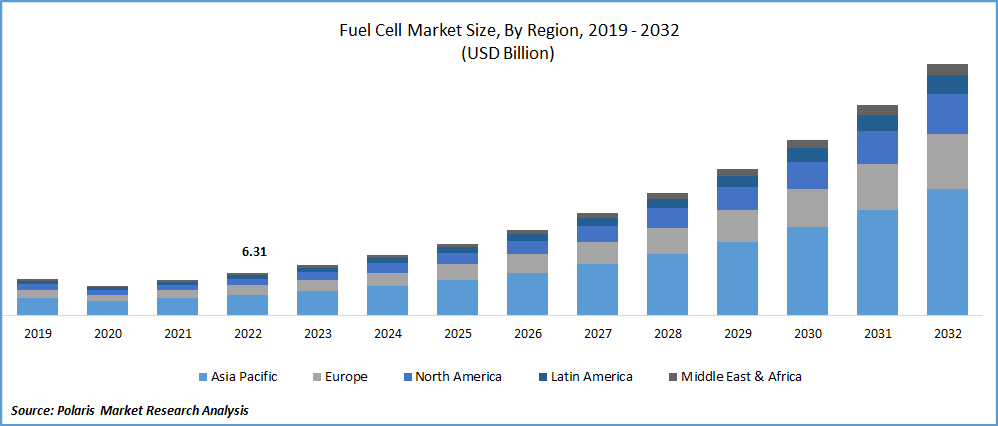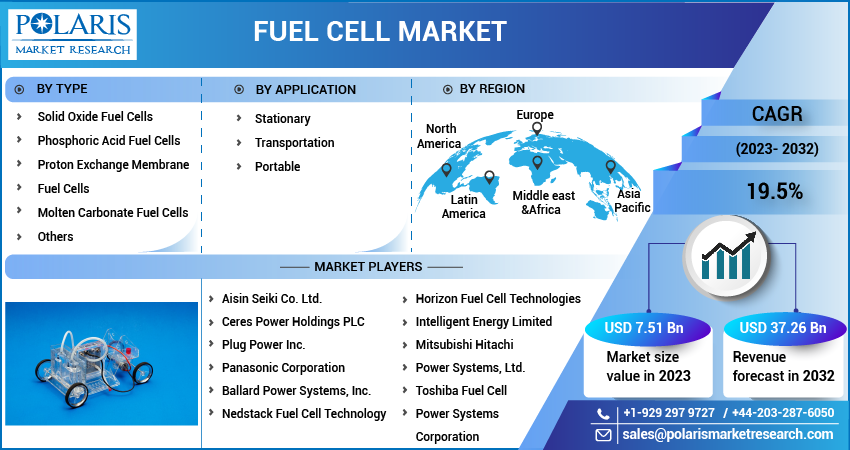
Fuel Cell Market Share, Size, Trends, Industry Analysis Report, By Type (Solid Oxide Fuel Cells, Phosphoric Acid Fuel Cells, Proton Exchange Membrane Fuel Cells, Molten Carbonate Fuel Cells, Others); By Application; By Region; Segment Forecast, 2023 - 2032
- Published Date:May-2023
- Pages: 114
- Format: PDF
- Report ID: PM1585
- Base Year: 2022
- Historical Data: 2019-2021
Report Outlook
The global fuel cell market was valued at USD 6.31 billion in 2022 and is expected to grow at a CAGR of 19.5% during the forecast period. The fuel cell industry is experiencing a steady growth due to the need for energy efficiency, rising energy costs, and demand for unconventional energy sources. The increasing adoption of power-efficient energy systems further supports the sector. Fuel cells have higher efficiency than other power-generating systems, and stringent government regulations regarding energy use and a growing need for improved energy systems boost their adoption.

Know more about this report: Request for sample pages
The market is also driven by supportive government regulations and incentives, growing awareness, adoption of distributed power systems, and technological advancements. Emerging economies, green technology adoption, and environmental concerns are expected to drive the adoption of fuel cells in the future. The industry will have growth opportunities due to technological advancements in hydrogen storage, investments, and demand for fuel cell vehicles.
Fuel cells are devices designed to produce electricity through a chemical reaction process. They consist of two electrodes, an anode and cathode, an electrolyte, and a catalyst. Fuel cells offer a clean method of electricity generation, as hydrogen and oxygen are combined to create water with very little pollution. Different fuel cell types include Alkali, Molten Carbonate, Proton Exchange Membrane (PEM), Phosphoric Acid, and Solid Oxide fuel cells. A PEM cell uses hydrogen and oxygen to produce electricity, water, and heat as reaction products. Fuel cells are a preferred alternative to internal combustion engines, coal, and nuclear power plants due to their reduced harmful by-product generation.
The market was impacted by the COVID-19 pandemic, with disruptions in the global supply chain causing delays in production and adoption in some industries. However, the pandemic also created opportunities for fuel cells in critical applications like healthcare and data centers. The effects varied by region, with China rebounding quickly due to government support and Europe experiencing delays. Despite challenges, the long-term outlook for the market remains positive as governments and industries prioritize decarbonization and renewable energy.

For Specific Research Requirements, Request for a Customized Report
Industry Dynamics
Growth Drivers
The market is experiencing significant growth due to various factors, including implementing stricter environmental regulations by governments worldwide to combat climate change. Fuel cells offer a clean and efficient source of power that can help meet these regulations, making them an attractive option for various industries.
Moreover, developing new and improved fuel cell technologies is driving down costs and improving performance, making fuel cells more competitive with traditional power sources. This, in turn, is increasing their adoption in various industries, contributing to market growth. Additionally, the growing demand for clean energy among consumers and businesses is another significant factor driving the expansion of the market.
Furthermore, the fuel cell market is attracting significant investment from public and private sources, which drives research and development and helps bring new and innovative fuel cell technologies to market. This investment is also creating new opportunities for fuel cell companies and contributing to the market's overall growth. Lastly, fuel cells are increasingly being adopted in key industries, such as transportation, stationary, and portable power, further driving growth and creating new opportunities for the market.
Report Segmentation
The market is primarily segmented based on type, application, and region.
|
By Type |
By Application |
By Region |
|
|
|
Know more about this report: Request for sample pages
Proton exchange membrane fuel cells segment held the largest market share in 2022
Proton Exchange Membrane Fuel Cells (PEMFC) segment held the largest market share. This type of fuel cell finds wide usage in various applications, such as forklifts, automobiles, telecommunications, primary systems, and backup power systems. PEMFC's versatility is a major factor that boosts its demand in the forecast period, given the increasing demand for clean power generation.
Additionally, PEMFC offers several advantages, such as improved reliability, high operational efficiency, low operational cost, less maintenance time, and others, which are expected to fuel the market growth.
Stationary segment led the revenue share in 2022
The stationary segment held the highest revenue share in 2022. This is attributed to the increasing demand for fuel cells from backup power applications and distributed generation facilities. Additionally, fuel cells are increasingly being utilized in combined heat and power applications. The versatility and high efficiency of stationary fuel cells enable them to maintain a leading position in the market.
The transportation segment is set to experience the highest growth rate in the fuel cell market, driven by the rising demand for fuel cell-powered forklifts and the increase in R&D activities in mature economies of Europe. Another contributing factor to the market's growth is the increasing use of portable fuel cells in personal electronics, laptops, and other portable products. Additionally, the market is expected to expand due to the growing investment in research and development aimed at producing hydrogen-powered hybrid vehicles in developed and developing countries.
Asia Pacific holds the significant revenue of global market in 2022
The Asia-Pacific region generated significant revenue in the global market in 2022 and is projected to maintain its lead throughout the forecast period. The region's market growth is driven by increasing consumer awareness and the growing number of applications. Furthermore, the expanding penetration of fuel-cell electric vehicles, the substantial rise in power consumption, and the increasing adoption of fuel cells in transport and stationary applications are expected to propel market growth in the Asia-Pacific region in the foreseeable future.
Competitive Insight
The leading players in the report include Aisin Seiki Co. Ltd., Ceres Power Holdings PLC, Plug Power Inc., Panasonic Corporation, Ballard Power Systems, Inc., Nedstack Fuel Cell Technology, Horizon Fuel Cell Technologies, Intelligent Energy Limited, Mitsubishi Hitachi Power Systems, Ltd., and Toshiba Fuel Cell Power Systems Corporation.
Recent Developments
- In June 2022, TuNur Ltd., has signed a Memorandum of Understanding (MoU) with FuelCell Energy, Inc. The agreement aims to provide low-carbon electricity and hydrogen to Europe and North Africa.
- In March 2022, Ceres and HORIBA MIRA partnered to accelerate hydrogen and fuel cell technology development and commercialization. The collaboration will leverage Ceres' expertise in fuel cell design and manufacturing and HORIBA MIRA's testing capabilities to accelerate the adoption of these technologies in various industries.
Fuel Cell Market Report Scope
|
Report Attributes |
Details |
|
Market size value in 2023 |
USD 7.51 billion |
|
Revenue forecast in 2032 |
USD 37.26 billion |
|
CAGR |
19.5% from 2023 – 2032 |
|
Base year |
2022 |
|
Historical data |
2019 – 2021 |
|
Forecast period |
2023 – 2032 |
|
Quantitative units |
Revenue in USD billion and CAGR from 2023 to 2032 |
|
Segments Covered |
By Type, By Application, By Region |
|
Regional scope |
North America, Europe, Asia Pacific, Latin America; Middle East & Africa |
|
Key Companies |
Aisin Seiki Co. Ltd., Ceres Power Holdings PLC, Plug Power Inc., Panasonic Corporation, Ballard Power Systems, Inc., Nedstack Fuel Cell Technology, Horizon Fuel Cell Technologies, Intelligent Energy Limited, Mitsubishi Hitachi Power Systems, Ltd., and Toshiba Fuel Cell Power Systems Corporation. |
FAQ's
key companies in fuel cell market are Aisin Seiki Co. Ltd., Ceres Power Holdings PLC, Plug Power Inc., Panasonic Corporation, Ballard Power Systems, Inc., Nedstack Fuel Cell Technology, Horizon Fuel Cell Technologies.
The global fuel cell market expected to grow at a CAGR of 19.5% during the forecast period.
The fuel cell market report covering key segments are type, application, and region.
key driving factors in fuel cell market are growing demand for clean energy and supportive government regulations and incentives.
The global Fuel Cell market size is expected to reach USD 37.26 billion by 2032.
